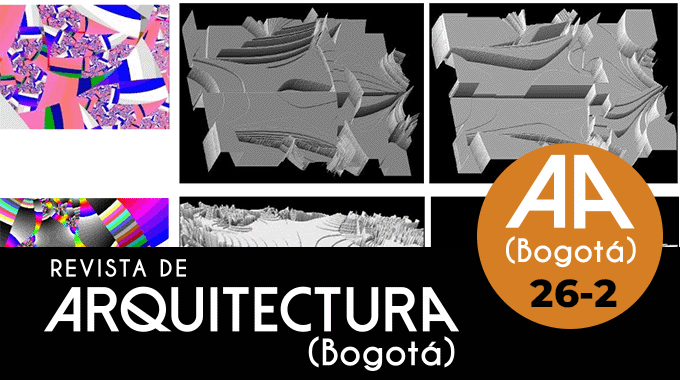

This work is licensed under a Creative Commons Attribution-NonCommercial 4.0 International License.
Revista de Arquitectura is an open access journal. More information...
Authors retain copyright and grant to the Revista de Arquitectura the right of first publication, which will be simultaneously subject to the Creative Commons (CC) BY-NC license.
Authors will sign a non-exclusive distribution license for the published version of the article by completing (RevArq FP03 Permission to Reproduce).
Self-archiving will comply with SHERPA/RoMEO guidelines and the Green classification.
To see in detail these guidelines, please consult...
Abstract
Since the late 20th century, a field of morphological exploration has been autonomously developing in various disciplines and fields of study. In the case of architecture, this autonomization has been based on a procedural, even algorithmic refinement of form, by expunging it and abstracting certain qualities, thereby extending, not without successive crises, the paradigm of pure forms derived from principles and aesthetic elaborations inherent to modernity. This has not only expanded this general principle, but also opened new ways of approaching it. With each new wave, it seems that new formal acts or configurations are explored and exhausted in their architectural expressions. Concepts such as patterns, folds, roofs and morphological envelopes,
modular growths and fragmentations, panel or piece decomposition or deconstruction, overlaps, deformations, among many others, only reinforce this general trend, understood as a refining deployment of the initial modern paradigm. This article reviews part of this paradigmatic
development and presents some of the author's experiences.

References
Albers, J. (2010). Selected works. Ed. Taschen.
Alexander, C. (2005a). Nature of order. Vol. 2. Ed. Center for Environmental Structure.
Alexander, C. (2005b). Nature of order. Vol. 3. Ed. Center for Environmental Structure.
Bateson, G. (1991). Pasos hacia la ecología de la mente. Ed. Lohlé-Lumen.
Cañete Islas, O. (2017). De tramas, fragmentos y paisajes digitales: morfogénesis y prototipos prearquitecturales. Revisión de una propuesta en progreso. Academia XXII, 8(15), 37-69. https://doi.org/10.22201/fa.2007252Xp.2017.15.60415
Cañete Islas, O. (2018a). El trazo sutil amplificado: dibujos de observación en Taller de Arquitectura. Academia XXII, 9(17), 130-151. https://doi.org/10.22201/fa.2007252Xp.2018.17.64883
Cañete Islas, O. E. (2018b). Ensamble organum: Experiencia docente en Arquitectura basada en modelaciones morfológicas según criterios algorítmico-procedimentales. Revista Scientific, 3(9), 174-189. https://doi.org/10.29394/Scientific.issn.2542-2987.2018.3.9.9.174-189 http://www.indteca.com/ojs/index.php/Revista_Scientific/article/view/234/202
Cañete-Islas, O. (2016). Exploraciones morfológicas en texturas modulares: aproximaciones desde el objet trouvé al diseño paramétrico. Revista de Arquitectura (Bogotá), 18(1), 76-97. https://doi.org/10.14718/RevArq.2016.18.1.8
Cañete, O. (2014). Arquitectura, complejidad y morfogénesis. Ed. Universidad de Valparaíso.
Cañete, O. (2020). Fractales. Hermenéutica de las formas puras. Ed. Universidad de Valparaíso.
Cañete, O. (editor) y Baamondes, C. (2011). Computación y arte visual gráfico. Proyecto FONDART de artes visuales. Ed. Garin.
Copper G., & Pocock-Williams, L. (1990). A selected chronology of computer art: exhibitions, publications, and technology. Art Journal, 49(3), 283-297. https://doi.org/10.1080/00043249.1990.10792704
De Sola-Morales, I. (2003). Inscripciones. Ed. GG.
Deleuze, G. (2000). El Pliegue. Ed. Gedisa.
Dietrich, F. (1985). Visual Intelligence: The first decade of computer art (1965-1975). IEEE Computer Graphics and Applications, 5, 33-45. http://www.megmitchell.com/course_docs/comp_designFall09Docs/readings/dietrich- leonardo.pdf
Guerra, S. (2017). Arquitectura conceptual. Conexiones entre el giro analítico del arte reciente y la investigación proyectual. Revista Pensum, 3, 40-52. https://revistas.unc.edu.ar/index.php/pensu/article/download/19017/18934/53200
Jonhson, N. (1982). Recent Works. PAGE, 49, 3-11. http://www.bbk.ac.uk/hosted/cache/archive/PAGE/PAGE49%20Autumn%201981.pdf
Kuhn, T. (1999). La estrutura de las revoluciones científicas. Ed. FCE
Lambert, N. (2003). A critical examination of computer art: its history and application. http://thesis.lambertsblog.co.uk/wp-content/uploads/2010/11/Newport-Lecture-05-
Letelier, S., & Brugnolli, F. (1992). Visualidad y neguentropia: un enfoque al equilibrio visual. Ed. Facultad de Arquitectura y Urbanismo. Universidad de Chile.
Lindenmayer, A., & Przemyslaw, P. (2000). The algorithmic beauty of plants. Ed. Springer-Verlag.
Mandelbrot, B. (2000). Los objetos fractales: forma, azar y dimensión. Ed. Tusquets.
Burton, J. I., Mladenoff, D. J., Clayton, M. K., & Forrester, J. A. (2011). The roles of environmental filtering and colonization in the fine-scale spatial patterning of ground-layer plant communities in north temperate deciduous forests. Journal of Ecology, 99, 764-776. https://doi.org/10.1111/j.1365-2745.2011.01807.x
Morin, E. (2008). Introducción al pensamiento complejo. Ed. Gedisa.
Prigogine, Ll. (1999). Entre el tiempo y la eternidad. Ed. Siglo XXI.
Prusinkiewicz, P., Lindenmayer, A., Fracchia, F., Hanan, J., & Krithivasan, K. (2013). Lindenmayer systems, fractals, and plants. Springer New York.
Rozin, D. (2010). An overview of artworks of Daniel Rozin. Ed. Bitforms Gallery.
Sola-Morales, I. (2003). Diferencias: topografía de la arquitectura contemporánea. Ed. GG.
Stentiford, F. M. (1982). Creative Computers. PAGE, 49, 12-14. http://www.bbk.ac.uk/hosted/cache/archive/PAGE/PAGE49%20Autumn%201981.pdf
Ursprung, P., & Eliasson, O. (2008). Studio Olafur Eliasson. An Encyclopedia. Ed. Taschen.
Vanoli, F. (2017). El pensamiento complejo y lo transdisciplinar en el abordaje del hábitat. Reflexiones en torno a la experiencia del seminario de gestión territorial y hábitat. Revista Pensum, 3, 141-146. https://revistas.unc.edu.ar/index.php/pensu/article/view/19033/18949
Varela, F. (1995). Conocer: Las ciencias cognitivas: tendencias y perspectivas. Cartografía de las ideas actuales. Ed. Gedisa.
Wagensberg, J. (2005). Procesos al azar. Ed. Tusquets.
Wagensberg, J. (2006). La revolución de las formas. Ed. Tusquets.
Weeghel, W. van (2022). Works. Willem van Weeghel kinetic objects [exposición]. http://www.willemvanweeghel.nl/en/
Withney, J. [crystalsculpture2] (1961). John Whitney "Catalog" [Video]. YouTube. http://www.youtube.com/watch?v=TbV7loKp69s&feature=player_embedded
Withney, J. [jordotech] (1971). John Whitney-Matrix (1971) [Video]. Youtube. http://www.youtube.com/watch?v=-fgxNQe-RV0&feature=related
Youngblood, G. (1970). Expanded Cinema. Ed. P. Dutton & Co. http://www.vasulka.org/Kitchen/PDF_ExpandedCinema/ExpandedCinema.html
Zaera P. (2002). Notas de un levantamiento topográfico. El Croquis, 79, 32-51.
Zubiri, X. (1990). Inteligencia sentiente. Ed. Alianza.
































